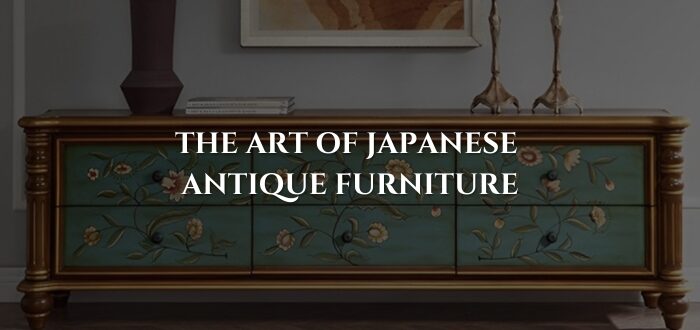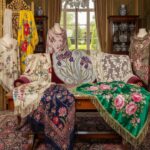The Art of Japanese Antique Furniture
What do you imagine when you hear the words “Japanese furniture”? Perhaps a chabudai (low, round table) atop a tatami straw mat? Maybe a Japanese Tansu chest? or a Shogi screen? Whether it is an antique Japanese desk or other Japanese vintage furniture, it cannot be denied that these Japanese furniture pieces possess their own allure and charm. Japanese antique furniture has carved out a unique space in modern interiors. With its clean lines, natural materials, and purposeful simplicity, antique Japanese furniture aligns beautifully with today’s desire for peaceful, clutter-free living. Rooted in principles like wabi-sabi (embracing imperfection) and ma (the space between objects), rare antique Japanese furniture was designed to balance beauty, form, and function.
Japanese furniture designs have been steadily increasing in abundance on the market.
Japanese furniture style is characterized by its minimalism, functionality, and connection to nature. It emphasizes clean lines, simple forms, and the use of natural materials like wood and bamboo.
Whether you’re a collector or simply someone seeking calm and authenticity in your home, Japanese antique furniture offers something rare: timeless elegance without excess.

Japandi: Japanese Calm Meets Scandinavian Warmth
When talking about Japanese furniture types and styles, the rising trend of the ‘Japandi’ style cannot be ignored.
Japandi style is the combination of Japanese and Scandi (Scandinavian) style and is one of the most searched interior design styles in the U.S. today. According to Google Trends and Pinterest analytics, interest in “Japandi” has reached record highs and continues to rise across design communities and retail platforms.
But what exactly is Japandi? At its core, Japandi is the fusion of two cultures that both champion simplicity, functionality, and serenity. It merges the Japanese minimalist furniture design with the warmth and softness of Scandinavian interiors.
Key Features of Japanese Style Furniture
1. Natural Materials
Japanese furniture prioritizes raw, natural materials that age gracefully.
Common woods: Hinoki (cypress), sugi (cedar), kiri (paulownia), keyaki (zelkova)
Textiles: Washi paper, cotton, linen, bamboo
Metals: Wrought iron for hinges and handles in tansu chests
These materials reflect the wabi-sabi philosophy: beauty in imperfection and impermanence.
2. Minimalist Aesthetic
Japanese furniture has clean lines, simple joinery, and little to no ornamentation.
Purpose: Avoids visual clutter, supports a tranquil space
The focus is always on balance, proportion, and quiet beauty.
3. Modularity and Functionality
Traditional pieces often serve multiple purposes or are easily moved or reconfigured.
Step tansu: served as both stairs and storage
Folding chabudai tables: stored when not in use
This reflects the pragmatic approach to small-space living in traditional Japanese homes.
4. Craftsmanship and Joinery
Japanese furniture is known for its meticulous joinery techniques—no screws or nails, just interlocking joints.
Dovetailing, mortise-and-tenon, butterfly joints
Entire pieces held together by pressure and balance
5. Sliding Elements & Space Division
Japanese interiors use shoji screens and fusuma (wood and fabric panels) to divide space instead of walls.
Promotes flexible room use
Allows for natural light and airflow
Types of Japanese Furniture
Here are the most iconic and collectible types of Japanese furniture you should know.
1. Tansu Chest
Tansu is a general term for traditional Japanese storage chests, developed during the Edo period (1603–1868). Made from woods like kiri (paulownia) or sugi (cedar), they often feature wrought-iron hardware, hidden compartments, and modular construction.
Why collectible:
- Historical utility and craftsmanship
- Iron hardware detailing
- Often contain hidden drawers or locks—a collector’s dream
2. Chabudai
Chabudai is a low dining or multipurpose table traditionally used in Japanese homes.
Features:
- Collapsible legs for storage
- Typically, square or round
- Simple wood construction
Why collectible:
- Embodies traditional Japanese family life
- Perfect for Japandi or minimalist spaces
3. Japanese Secretarial Desk
A compact, portable writing desk used by scholars, monks, and officials. Typically, a wooden box with drawers, an inkstone holder, and writing surfaces that open and close like a secretary desk.
Why collectible:
- Rare and specialized
- Appeals to scholars, writers, and collectors of Japanese culture
- Often intricately joined with superb craftsmanship
This Japanese Wood Secretary Desk with elaborate floral designs, fitted drawer, and slots for stationery storage was a favourite among Oriental furniture collectors and sold for an incredible price at a past Giftex auction.
4. Shoji Screens & Fusuma Panels
These are sliding doors or screens made of wood and rice paper or cloth. Shoji lets in light and divides rooms subtly.
Why collectible:
- Highly desirable in Japandi and open-plan interiors
- Lightweight, elegant, and culturally iconic
5. Kotatsu (Heated Tables)
Kotatsu, a heated table used in winter. A low table frame holds a heat source underneath (traditionally charcoal, now electric). A futon-like blanket is draped over the frame, and a tabletop sits on top.
Traditional vs. Modern:
a. Traditional kotatsu: used charcoal braziers and heavier quilts
b. Modern kotatsu: plug-in heaters, safety timers, sleeker design
Why collectible:
- Traditional kotatsu are rare outside Japan
- Seen as both functional and cultural artefacts
Also Read: Sustainable Antique Furniture
How to Style Your Home with Japanese Furniture
Here are some tips on styling your home with traditional Japanese-style furniture
1. Embrace Minimalist Patterns
- Japanese interiors rarely use bold patterns or excessive ornamentation. Instead, the focus is on subtle textures and understated forms.
- Opt for neutral-tone tatami mats, unpatterned linen cushions, and textured ceramics.
2. Use Natural Wood & Organic Materials
- Japanese furniture is all about natural materials that age beautifully.
- Feature a Tansu chest as a focal point or use a chabudai table for dining or tea.
- Leave wood unpainted to let its natural tones shine.
3. Embrace the Concept of Ma
Ma refers to the space between things—a core idea in Japanese design. It’s about creating intentional emptiness so each object can breathe and be noticed.
- Leave space between furniture. Don’t press pieces against walls.
- Keep shelves minimally styled
- In floor seating setups, leave wide gaps between cushions and tables to emphasize openness.
4. Incorporate Japandi for a Soft-Modern Look
- Pair low Japanese pieces like a Tansu or zaisu chair with Scandinavian-style sofas or open shelving in oak or birch.
- Mix light woods with stoneware, wool rugs, and neutral fabrics to soften the space.
5. Keep It Simple, Add Greenery for Life
- Japanese interiors honour simplicity, clarity, and the natural world. But that doesn’t mean your space has to feel sterile.
- Bring life in with vases of greenery, such as a single stem of bamboo, a bonsai tree, or a small ikebana arrangement.
- Stick to one or two accents per room to avoid overpowering the calm.
Also Read: A Guide to Japanese Pottery
Antique Japanese Furniture Meets Modern Minimalism
Japanese antique furniture is more than a style—it’s a philosophy of design, restraint, and quiet strength. When integrated with modern sensibilities through the Japandi aesthetic, these pieces bring life, depth, and calm into your living space.
Styling your home with Japanese furniture isn’t about adding more—it’s about subtracting the unnecessary to reveal the meaning. Whether you go traditional or blend into Japandi, focus on balance, intention, and authenticity. Start with one piece—a Tansu, a chabudai, or a zaisu—and let your space evolve around it, slowly and purposefully.






